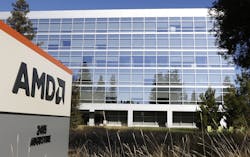AMD Takes Aim at Data Centers with $1.9 Billion Bid for Pensando
AMD said on Monday it plans to buy a networking chip startup founded by ex-Cisco engineers, in a bid to more effectively compete with Intel, NVIDIA, and others in a relatively new category of data-center chip.
The Santa Clara, California-based company announced it will acquire Pensando in a $1.9 billion deal set to close in the second quarter, placing it at the forefront of the emerging market for data processing units (DPUs).
Pensando’s DPUs are powered by a custom, programmable packet-processing chip that is designed to offload software-defined networking, storage, security, and various other services from the CPU in a server.
“To build a leading-edge data center with the best performance, security, flexibility, and lowest total cost of ownership requires a wide range of compute engines,” said Lisa Su, chief executive of AMD, in a statement.
The agreement comes a month after AMD completed its near-$50 billion deal to buy Xilinx, cementing its status as one of the leaders of the U.S. semiconductor industry. The deal added Xilinx’s field-programmable gate arrays (FPGAs) and systems-on-a-chip (SoCs) to AMD’s EPYC CPUs and Instinct GPUs for the data center.
AMD's latest acquisition further fills out its product portfolio, giving it access to hardware and software that complements the CPUs and GPUs that are on the rise with companies operating massive data centers.
The company’s board is chaired by former Cisco CEO John Chambers. It has secured several prominent customers, such as Goldman Sachs and the cloud-computing businesses of IBM, Microsoft, and Oracle.
Su said it “expands our ability to offer leadership solutions for our cloud, enterprise, and edge customers.”
The Cloud's Traffic Cop
Today, AMD sells central processors to all of the top cloud-computing players, including Alphabet’s Google, Amazon, and Microsoft, as well as technology giants such as Meta. The company is spending aggressively on server gear to pack more performance into its data centers that form the backbone of the internet. But as these companies scale up operations, moving data from one server to another becomes a bottleneck.
Today, the CPU in the server acts as a sort of traffic cop in a data center, running software that moves data between storage, special-purpose accelerators for cryptography or other chores, and the Ethernet network.
But relying on a CPU to coordinate the traffic in a data center is expensive and inefficient. More than one-third of a general-purpose server CPU’s capacity is consumed by carrying out behind-the-scenes chores.
Pensando is trying to convince cloud firms to attach DPUs to millions of servers inside their colossal data centers, which they use themselves and rent to millions of customers over the cloud. Pensando said that its DPUs are supplemented by a software stack that takes care of ferrying data to the right physical gear.
The startup said DPUs free up the CPUs at the center of the server to run other functions. It offers about 10 times faster performance and consumes less power at 1/3 of the total cost of ownership (TCO) of existing systems.
The chips are packaged on PCI Express (PCIe) cards that slot into servers, or they can be integrated directly into networking gear.
DPU Market Ramps Up
The deal brings AMD into a market that has become a huge data-center battleground in recent years, with server chips giants such as Broadcom, Intel, Marvell, Xilinx (pre-AMD), and others rolling out new products.
Intel is wrestling to win more market share in the category with what it calls its infrastructure processor units (IPUs). Last year, the server chip giant launched its latest programmable IPU code-named Mount Evans.
Also last year, NVIDIA announced its latest line of DPUs, called Bluefield-3, which promises to offload up to 300 CPU cores worth of I/O workloads, which in turn reduces operating costs throughout the data center. Moreover, Marvell rolled out its Octeon 10 series of DPUs, which are based on the 5-nm node from TSMC and take advantage of Arm's Neoverse N2 core. Fungible is another startup competing for a slice of the market.
Major cloud-computing firms are also investing more in internally designed silicon to run the infrastructure at the heart of their data centers. For years, AWS has rolled out a set of hardware and software that plays roughly the same role as a DPU (sometimes also known as a smart network interface card, or SmartNIC). Called Nitro, it runs on Arm-based chips designed in-house and offloads many of the same storage and networking chores as a DPU.
Pensando is one of the up-and-coming companies in the DPU market, having started operations only five years ago. The startup has raised more than $300 million in venture funding from the likes of HPE and Qualcomm.
Pensando said partners and customers have already put more than 100,000 of its platforms into production.
“Pensando’s leadership position in software-defined cloud, compute, networking, security, and storage services as part of the much larger AMD portfolio is in my opinion a perfect fit to shape the data-center computing landscape for the next decade,” said Chambers, former Cisco CEO and Pensando chairman.
Once the deal is closed, Pensando CEO Prem Jain and the Pensando team, which stands at around 350 employees, will be integrated into AMD’s data-center business headed by Forrest Norrod.
About the Author
James Morra
Senior Editor
James Morra is the senior editor for Electronic Design, covering the semiconductor industry and new technology trends, with a focus on power electronics and power management. He also reports on the business behind electrical engineering, including the electronics supply chain. He joined Electronic Design in 2015 and is based in Chicago, Illinois.

